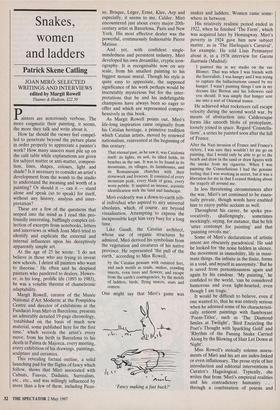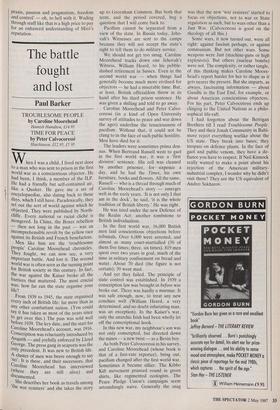Snakes, women and ladders
Patrick Skene Catling
JOAN MIRO: SELECTED WRITINGS AND INTERVIEWS edited by Margit Rowell Thames & Hudson, £22.50 Painters are notoriously verbose. The more enigmatic their painting, it seems, the more they talk and write about it.
How far should the viewer feel compel- led to penetrate beyond the picture plane in order properly to appreciate a painter's work? How many saucers must pile up on the café table while explanations are given for subject matter or anti-matter, composi- tion, lines, shapes, colours, light and shade? Is it necessary to consider an artist's development from the womb to the studio to understand the meaning and worth of a painting? Or should it — can it — stand alone and speak (so to speak) for itself, without any history, analysis and inter- pretation?
These are a few of the questions that seeped into the mind as I read this pro- foundly interesting, bafflingly complex col- lection of excerpts from notebooks, letters and interviews in which Joan Mir6 tried to identify and explicate the external and internal influences upon his deceptively apparently simple art.
At the age of 25 he wrote: 'I do not believe in those who are trying to invent new schools. I detest all painters who want to theorise.' He often said he despised painters who pandered to dealers. Howev- er, in his long, prolific life (1893 to 1983), he was a voluble theorist of chameleonic adaptability.
Margit Rowell, curator of the Musee National d'Art Moderne at the Pompidou Centre and director of exhibitions at the Fundaci6 Joan Mir6 in Barcelona, presents an admirably detailed 19-page chronology, 'estabished on the basis of much new material, some published here for the first time,' which records the artist's every move, from his birth in Barcelona to his death in Palma de Majorca, every meeting, every exhibition of his drawings, paintings, sculpture and ceramics.
This revealing factual outline, a solid launching pad for the flights of fancy which follow, shows that Mire) associated with Cubists, Fauves, Dadaists, Surrealists, etc., etc., and was willingly influenced by more than a few of them, including Picas- so, Braque, Leger, Ernst, Klee, Arp and especially, it seems to me, Calder. Mir6 encountered just about every major 20th- century artist in Barcelona, Paris and New York. His most effective dealer was the powerful, continuously fashionable Pierre Matisse.
And yet, with confident single- mindedness and persistent industry, Mir6 developed his own dreamlike, cryptic icon- ography. It is recognisable now on any scale, from his smallest painting to his biggest mosaic mural. Though his style is quite easy to appreciate, the supposed significance of his work perhaps would be inscrutably mysterious but for the inter- pretations that he and his indefatigable champions have always been so eager to offer and which are represented compre- hensively in this book.
As Margit Rowell points out, Mir6's life-long inspiration came originally from his Catalan heritage, a primitive tradition which Catalan artists, moved by renewed nationalism, reinvented at the beginning of this century:
That eternal past, as he saw it, was Catalonia itself: its lights, its soil, its tilled fields, its beaches in the sun. It was to be found in its mountains, its villages, its farmhouses, and its Romanesque churches with their stonework and frescoes. It consisted of every mountain peak, every blade of grass, every worn pebble. It inspired an intense, atavistic identification with the land and landscape.
Mir6 evidently was a down-to-earth trib- al individual who aspired to airy universal absolutes, which, of course, are beyond visualisation. Attempting to express the inexpressible kept him very busy for a long time.
Like Gaudf, the Catalan architect, whose use of organic structures he admired, Mir6 derived his symbolism from the vegetation and creatures of his native province. He represented 'the pull of the earth,' according to Miss Rowell,
by the • Catalan peasant with outsized feet, and such motifs as snails, snakes, crawling insects, even trees and flowers; and escape from the earth's contingencies, by the motifs of ladders, birds, flying insects, stars and comets.
One might say that Mir6's game was snakes and ladders. Women came some- where in between.
His relatively realistic period ended in 1922, when he finished 'The Farm', which was acquired later by Hemingway. Mir6's poverty in 1924 gave him new subject matter, as in 'The Harlequin's Carnival', for example. He told Lluis Permanyer about it, in a 1978 interview for Gaceta Ilustrada (Madrid):
I painted this in my studio on the rue Blomet. That was when I was friends with the Surrealists. I was hungry and I was trying to capture the hallucinations caused by my hunger. I wasn't painting things I saw in my dreams like Breton and his followers said you should. It was simply that hunger sent me into a sort of Oriental trance.
He achieved what rocketeers call escape velocity during the second world war, by means of abstraction into Calderesque forms like smooth blobs of protoplasm, loosely joined in space. Regard 'Constella- tions', a series he painted soon after the fall of France.
After the Nazi invasion of France and Franco's victory, I was sure they wouldn't let me go on painting, that I would only be able to go to the beach and draw in the sand or draw figures with the smoke from my cigarette. When I was painting the Constellations I had the genuine feeling that I was working in secret, but it was a liberation for me in that I ceased thinking about the tragedy all around me.
In less threatening circumstances after the war, Mir6's art continued to be essen- tially private, though words have enabled him to enjoy public acclaim as well.
Throughout his career, he spoke pro- vocatively, challengingly, sometimes mockingly, saying, for instance, that he felt `utter contempt for painting' and that `painting revolts me'.
Some of Mir6's declarations of artistic intent are obscurely paradoxical. He said he looked for 'the noise hidden in silence, the movement in immobility, life in inani- mate things, the infinite in the finite, forms in a void, and myself in anonymity.' But he is saved from pretentiousness again and again by his candour. 'My painting,' he confided to the world, 'can be considered humorous and even light-hearted, even though I am tragic.'
It would be difficult to believe, even if one wanted to, that he was entirely serious when he adorned some of his characteristi- cally reticent paintings with flamboyant `Poem-Titles', such as 'The Diamond Smiles at Twilight', 'Bird Encircling the Poet's Thought with Sparkling Gold' and `Rhythm of the Passing Snake Carried Along by the Blowing of Hair Let Down at Night'.
Miss Rowell's stoically solemn assess- ments of Mir6 and his art are index-linked or even inflationary. The prose style of her introduction and editorial interventions is Curator's Hagiological. Typically, she writes that from 'Mires empirical realities and his contradictory humanity . . through a combination of poiesis and praxis, passion and pragmatism, freedom and control' — oh, to hell with it. Wading through stuff like that is a high price to pay for an enhanced understanding of Mil-6's reputation.



















































 Previous page
Previous page